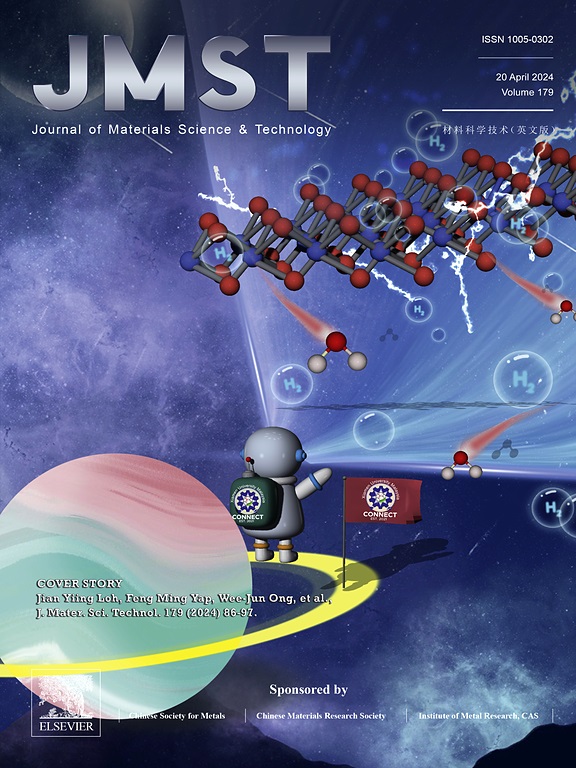Self-supported coaxial nanocable CuO@Ni(OH)2@FeOOH heterojunction arrays catalyst with interfacial coupling for enhanced oxygen evolution and urea oxidation reactions
IF 11.2
1区 材料科学
Q1 MATERIALS SCIENCE, MULTIDISCIPLINARY
引用次数: 0
Abstract
It is of essential importance to exploit electrocatalysts with excellent performance for anodic reactions in electrochemical water splitting, such as oxygen evolution reaction (OER) and urea oxidation reaction (UOR). Herein, we delicately constructed a coaxial nanocable-like structure containing Cu foam-supported CuO NWs as core and Ni(OH)2@FeOOH heterogeneous nanosheets as a porous sheath (i.e., CuO@Ni(OH)2@FeOOH NWs/CF). The particular architecture with 1D nanoarray frameworks in-situ grown on 3D conductive substrate and hierarchical microstructure ensures the adequate exposure of the active sites, facilitative electron/mass transfer, and high structural stability. Combined experimentation and DFT calculation demonstrate that Ni(OH)2 and CuO in the hybrid served as active metal ions and scaffold for providing a fast electron conducting path, respectively. Meanwhile, FeOOH acted as an inductive agent to attract charge reorganization of adjacent Ni sites, thus modulating the electron structure and optimizing the d-band centers. Strengthened by the above desirable characteristics, CuO@Ni(OH)2@FeOOH NWs/CF exhibited superior electrocatalytic activities towards both OER and UOR with a small overpotential of 310 mV and low potential of 1.37 V at 100 mA cm−2, respectively, as well as the expected electrocatalytic stability. This work affords a way to design highly active catalysts via constructing heterojunctions for various applications.

具有界面偶联的自支撑同轴纳米电缆CuO@Ni(OH)2@FeOOH异质结阵列催化剂,用于增强析氧和尿素氧化反应
开发性能优良的电催化剂用于电化学水分解中的阳极反应,如析氧反应(OER)和尿素氧化反应(UOR)。在此,我们精心构建了一个同轴纳米电缆状结构,其中包含Cu泡沫支撑的CuO NWs作为核心,Ni(OH)2@FeOOH非均相纳米片作为多孔护套(即CuO@Ni(OH)2@FeOOH NWs/CF)。在三维导电衬底上原位生长的一维纳米阵列框架的特殊结构和分层微观结构确保了活性位点的充分暴露,促进了电子/质量传递和高结构稳定性。结合实验和DFT计算表明,杂化物中的Ni(OH)2和CuO分别作为活性金属离子和支架提供了快速的电子传导路径。同时,FeOOH作为诱导剂吸引相邻Ni位点的电荷重组,从而调节电子结构,优化d带中心。在上述理想特性的强化下,CuO@Ni(OH)2@FeOOH NWs/CF对OER和UOR均表现出优异的电催化活性,在100 mA cm−2下的过电位分别为310 mV和1.37 V,并具有预期的电催化稳定性。这项工作提供了一种通过构建异质结来设计高活性催化剂的方法。
本文章由计算机程序翻译,如有差异,请以英文原文为准。
求助全文
约1分钟内获得全文
求助全文
来源期刊

Journal of Materials Science & Technology
工程技术-材料科学:综合
CiteScore
20.00
自引率
11.00%
发文量
995
审稿时长
13 days
期刊介绍:
Journal of Materials Science & Technology strives to promote global collaboration in the field of materials science and technology. It primarily publishes original research papers, invited review articles, letters, research notes, and summaries of scientific achievements. The journal covers a wide range of materials science and technology topics, including metallic materials, inorganic nonmetallic materials, and composite materials.
 求助内容:
求助内容: 应助结果提醒方式:
应助结果提醒方式:


